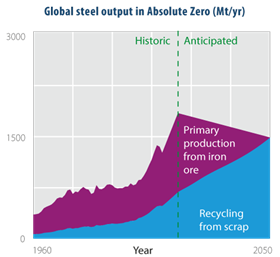Julian Allwood, Professor of Engineering and the Environment, has published an open letter to express concern about the definition of “near zero emissions” proposed in an IEA report. released ahead of COP27.
The letter, published this week, refers to the International Energy Agency’s report “Achieving Net Zero Heavy Industry Sectors in G7 Members” which was developed in co-operation with the incumbent industrial players, including the high-emitting blast furnace primary steel producers. In the report, ‘near-zero emissions’ is defined based on improvements in emissions relative to today’s levels, rather than in absolute terms.
Figure 1: Anticipated reduction in primary steel production. Graph from Absolute Zero
‘Absolute emissions’ says Allwood ‘is the only metric which matters in climate science and policy. The IEA definition risks favouring relative improvement in the high-emitting primary steel production over the already-low-emitting Electric Arc Furnace production. This risks allowing primary producers a form of 'greenwashing' if labelling steel as “lower emissions” even when it causes much higher emissions than Electric Arc Furnace production.’
In a zero-emissions future, recycled steel in electric arc furnaces could supply most of our needs for steel. Additionally, recycled steel can have at least the same quality as primary steel, and even without climate action, our stock of steel available for recycling will treble by 2050. In contrast, blast-furnace primary steel making inevitably leads to emissions due to the chemical reaction involved in extracting pure iron from iron ore using the carbon in coal. In order to meet the requirement of zero emissions by 2050, the only valuable resource is electrically recycled steel as there is currently no alternative technology for producing primary steel without emissions.
Allwood argues that the only metric of importance is the total emissions per tonne of steel produced – which must be absolute zero rather than ‘near zero’ - and the only scalable option for zero-emissions steel production over that time period, is the expansion of high-quality electric steel recycling.

